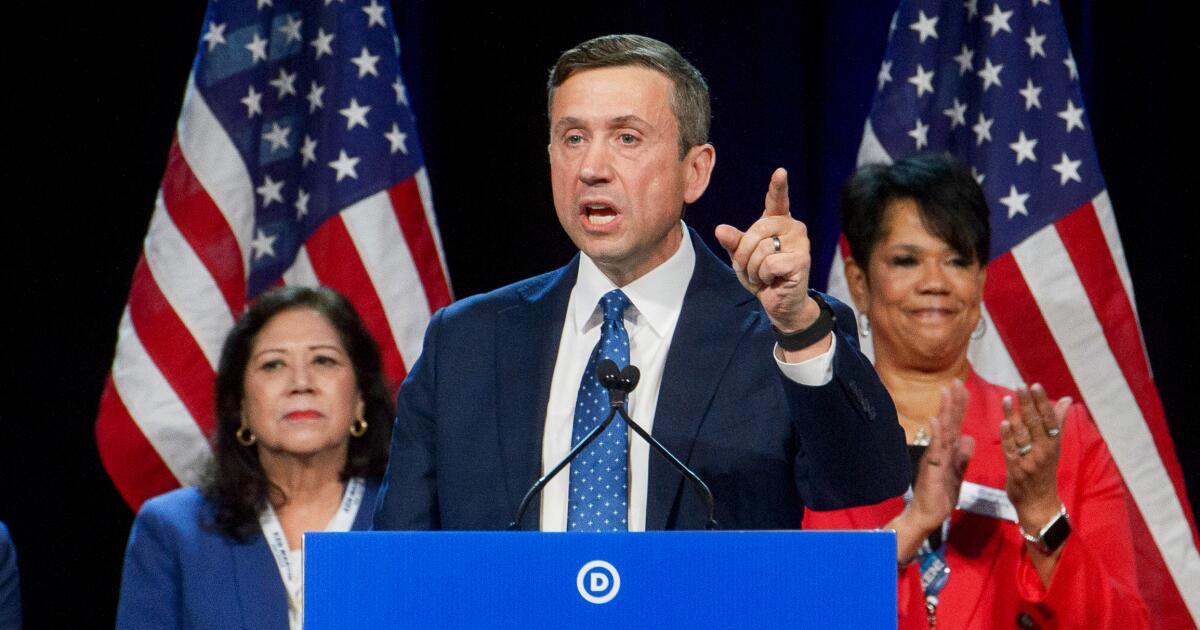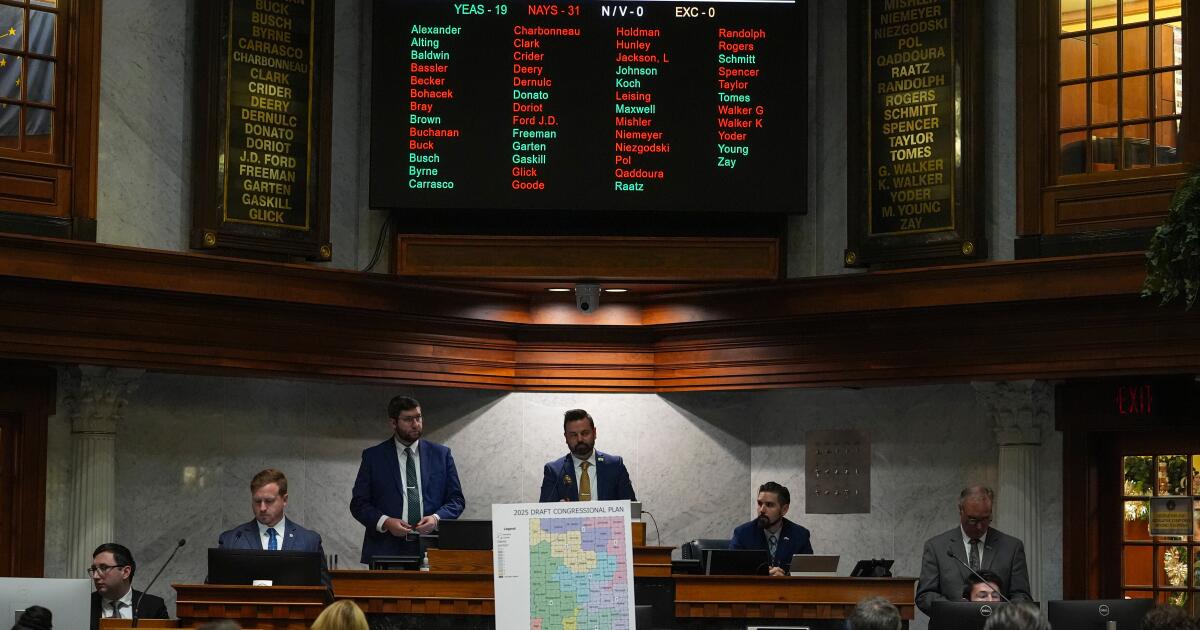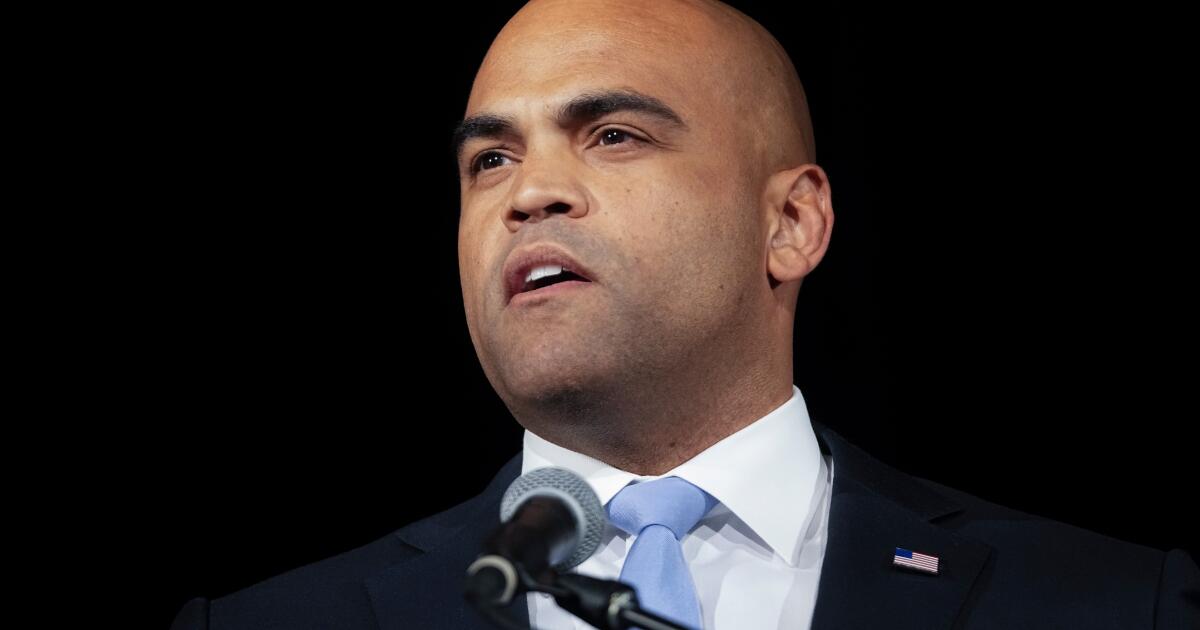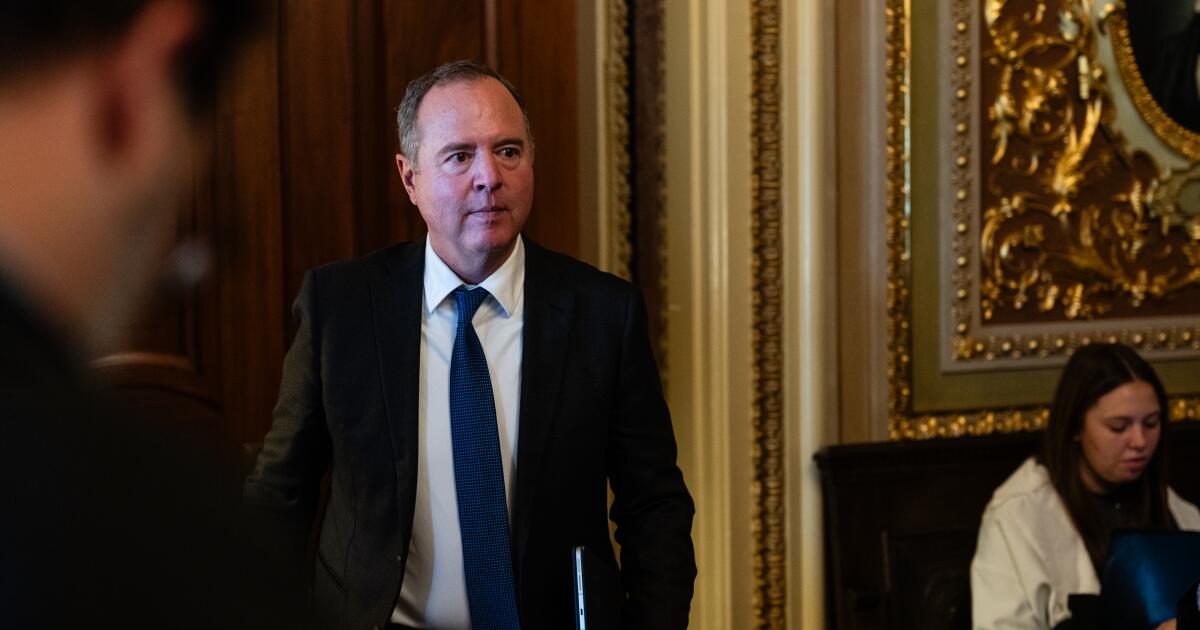Five months after joining the U.S. Senate, Adam Schiff delivered a floor speech on what he called “the top 10 deals for Donald Trump and the worst deals for the American people.”
Schiff spoke of Trump and his family getting rich off cryptocurrency and cutting new development deals across the Middle East, and of the president accepting a free jet from the Qatari government. Meanwhile, he said, average Americans were losing their healthcare, getting priced out of the housing market and having to “choose between rent or groceries.”
“Trump gets rich. You get screwed,” the Democrat said.
The speech was classic Schiff — an attempt by the former prosecutor to wrangle a complex set of graft allegations against Trump and his orbit into a single, cohesive corruption case against the president, all while serving up his own party’s preferred messaging on rising costs and the lack of affordability.
It was also a prime example of the tack Schiff has taken since being sworn in one year ago to finish the final term of the late Sen. Dianne Feinstein, a titan of California politics who held the seat for more than 30 years before dying in office in 2023.
Schiff — now serving his own six-year term — has remained the unblinking antagonist to Trump that many Californians elected him to be after watching him dog the president from the U.S. House during Trump’s first term in the White House. He’s also continued to serve as one of the Democratic Party’s most talented if slightly cerebral messengers, hammering Trump over his alleged abuses of power and the lagging economy, which has become one of the president’s biggest liabilities.
Schiff has done so while also defending himself against Trump’s accusations that he committed mortgage fraud on years-old loan documents; responding to the devastating wildfires that ripped through the Los Angeles region in January; visiting 25 of California’s 58 counties to meet more of his nearly 40 million constituents; grilling Trump appointees as a member of the Senate Judiciary Committee; and struggling to pass legislation as a minority member of a profoundly dysfunctional Congress that recently allowed for the longest federal government shutdown in U.S. history.
It’s been an unusual and busy freshman year, attracting sharp criticism from the White House but high praise from his allies.
“Pencil Neck Shifty Schiff clearly suffers from a severe case of Trump Derangement Syndrome that clouds his every thought,” said Abigail Jackson, a White House spokesperson. “It’s too bad for Californians that Pencil Neck is more focused on his hatred of the President than he is on the issues that matter to them.”
“He’s been great for California,” said Rep. Robert Garcia of Long Beach, ranking Democrat on the House Oversight and Government Reform Committee who endorsed Schiff’s opponent, former Rep. Katie Porter, in the Senate primary. “He’s not afraid of taking on Trump, he’s not afraid of doing tough oversight, he’s not afraid of asking questions, and it’s clear that Donald Trump is scared of Adam Schiff.”
“While he may be a freshman in the Senate,” said Sen. Alex Padilla (D-Calif.), “he’s certainly no rookie.”
Attempts to legislate
Before he became known nationally for helping to lead Trump’s first-term impeachments and investigate the Jan. 6 storming of the U.S. Capitol by Trump’s supporters, Schiff was known as a serious legislator. Since joining the Senate, he has tried to reclaim that reputation.
He has introduced bills to strengthen homes against wildfires and other natural disasters, give tax relief to Los Angeles fire victims, strengthen California’s fire-crippled insurance market, study AI’s impact on the American workforce, reinstate a national assault weapons ban and expand federal tax credits for affordable housing.
He has also introduced bills to end Trump’s tariffs, rein in the powers of the executive branch, halt the president and other elected officials from getting rich off cryptocurrencies, and end the White House-directed bombing campaign on alleged drug boats in the Caribbean.
None of that legislation has passed.
Schiff said he’s aware that putting his name on legislation might diminish its chances of gaining support, and at times he has intentionally taken a back seat on bills he’s worked on — he wouldn’t say which — to give them a better shot of advancing. But he said he also believes Democrats need to “point out what they’re for” to voters more often, and is proud to have put his name on bills that are important to him and he believes will bring down costs for Californians.
As an example, he said his recent Housing BOOM (Building Occupancy Opportunity for Millions) Act is about building “millions of new homes across America, like we did after World War II, that are affordable for working families,” and is worth pushing even if Republicans resist it.
“As we saw with the healthcare debate, when Republicans aren’t acting to bring costs down, when they’re doing things that make costs go up instead, we can force them to respond by putting forward our own proposals to move the country forward,” he said. “If Republicans continue to be tone deaf to the needs of the American people, with President Trump calling the affordability issue a hoax, then they’re gonna get the same kind of shellacking that they did in the election last month.”
Rep. Nancy Pelosi (D-San Francisco), a staunch ally, called Schiff a “legislative genius” who is “giving people hope” with his bills, which could pass if Democrats win back the House next year.
“He has a vision for our country. He has knowledge of issues par excellence from all of the years that he’s served. He’s a strategic thinker,” she said. “I wouldn’t question how he decides to take up a bill just because what’s-his-name’s in the White House.”
Mike Madrid, a Republican consultant, said Schiff’s prominent position on Trump’s enemies list of course hurts his chances of passing legislation, but the hyper-partisan nature of Congress means his chances weren’t great to begin with.
Meanwhile, being seen as working for solutions clearly serves him and his party well, Madrid said, adding, “He’s probably accomplishing more socially than he ever could legislatively.”
Criticism and praise
For months, Trump and his administration have been accusing several prominent Democrats of mortgage-related crimes. Trump has accused Schiff of mortgage fraud for claiming primary residency in both California and Maryland, which Schiff denies.
So far, nothing has come of it. Schiff said that he has not been interviewed by federal prosecutors, who are reportedly skeptical of the case, and that he doesn’t know anything about it other than that it is “a broad effort to silence and intimidate the president’s critics.”
Schiff’s supporters and other political observers in the state either ignored the issue when asked about Schiff’s first year, were dismissive of it or said they saw it as a potential asset for the senator.
“Adam Schiff is a person of great integrity, and people know that,” Pelosi said.
“Probably one of the best things that could happen to Schiff is if Trump actually goaded the [Justice Department] to charge him for mortgage fraud, and then for the case to be thrown out in court,” said Garry South, a veteran Democratic strategist — noting that is what happened with a similar case brought against New York Atty. Gen. Letitia James.
“He’s really benefited from having Trump put a target on his back,” South said. “In California, that’s not a death knell, that’s a life force.”
Sen. John Boozman (R-Ark.), who chairs the Senate Agriculture, Nutrition and Forestry Committee, which Schiff sits on, said California represents a big part of the nation’s agriculture industry and having Schiff on the committee “is a good thing not just for California, but for our overall efforts to support farmers and producers nationwide.”
“I have known Sen. Schiff since we served in the House together, and we are both committed to advocating farmers’ and rural America’s needs in a bipartisan way,” Boozman said. “We look forward to more opportunities to advance these goals together.”
Sen. Chuck Grassley (R-Iowa), who chairs the Judiciary Committee, has “a cordial, professional relationship” with Schiff, a spokesperson said.
Corrin Rankin, chairwoman of the California Republican Party, declined to comment. Riverside Sheriff Chad Bianco, the leading Republican in the race for governor, did not respond to a request for comment.
Looking ahead
What comes next for Schiff will depend in part on whether Democrats win back a majority in Congress. But people on both sides of the political aisle said they expect big things from him regardless.
Garcia said Schiff will be “at the center of holding the Trump administration accountable” no matter what happens. “Obviously, in the majority, we’re going to have the ability to subpoena, and to hold hearings, and to hold the administration accountable in a way that we don’t have now, but even in the minority, I think you see Adam’s strong voice pretty constant.”
Kevin Spillane, a veteran GOP strategist, said he doesn’t make much of Schiff’s economic messaging because voters in California know that Democrats have caused the state’s affordability crisis by raising taxes and imposing endless regulations.
But Schiff is already “the second-most important Democrat in California” after Newsom, he said, and his hammering on affordability could propel him even further if voters start to see him as working toward solutions.
Rob Stutzman, another Republican consultant, said he can see Schiff in coming years “ascend to the Feinstein role” of “the caretaker of California in the U.S. Congress” — someone with “the ability to broker deals” on hugely important issues such as water and infrastructure. But to do so, Stutzman said, Schiff “needs to extract himself from the political meme of being a Trump antagonist.”
Schiff said he knew heading to the Senate as Trump returned to the White House that he would be dividing his time “between delivering for California and fighting the worst of the Trump policies.” But his efforts to fix the economy and his efforts to resist Trump are not at odds, he said, but deeply intertwined.
“When people feel like the quality of life their parents had was better, and the future for their kids looks like it’s even more in doubt, all too many are ready to entertain any demagogue who comes along promising they alone can fix it. They start to question whether democracy really works,” he said. “So I don’t think we’re going to put our democracy on a solid footing until we have our economy on a solid footing.”
Times staff writer Ana Ceballos in Washington contributed to this report.

























